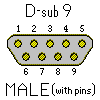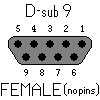Difference between revisions of "Atari Controller Interfaces"
m (formatting pin-out table) |
m (added home computer links) |
||
| (5 intermediate revisions by the same user not shown) | |||
| Line 1: | Line 1: | ||
== Stelladaptor == | == Stelladaptor == | ||
| − | [http://www.atariage.com/store/index.php?main_page=product_info&products_id=267 Stelladaptor] is a USB interface specifically for 2600 joysticks, paddles and trackballs. | + | [http://www.atariage.com/store/index.php?main_page=product_info&products_id=267 Stelladaptor] is a USB interface specifically for [[Atari 2600]] joysticks, paddles, and trackballs. |
== Keyboard Encoders == | == Keyboard Encoders == | ||
| − | Atari 2600 and 7800 | + | Joysticks for Atari 2600 and [[Atari 7800]] consoles (and compatible systems like: [[Home Computers#Atari 400|Atari 400]]/[[Home Computers#Atari 800|800]]/[[Home Computers#Atari ST|ST]] computers, [[Home Computers#Commodore C64|Commodore C64]], [[Sega Master System]], [[Sega Genesis/Megadrive/32X]], and others) are fairly easy to interface with [[Keyboard Encoders]]. The joystick cords end in standard D-sub 9 female connectors. Each of the 9 pins corresponds to one directional, fire, or common signal. |
| − | + | <gallery> | |
| − | {| border="1" cellpadding="5" cellspacing="0" align="center" | + | Image:dsub9m.gif|D-sub 9 pin male connector pinout diagram |
| + | Image:dsub9m.jpg|D-sub 9 pin male connector photo | ||
| + | Image:dsub9f.gif|D-sub 9 female connector pinout diagram | ||
| + | </gallery> | ||
| + | |||
| + | Here are the pin-outs: | ||
| + | {| | ||
| + | {|border="1" cellpadding="5" cellspacing="0" align="center" width="50%" | ||
|+'''2600:''' | |+'''2600:''' | ||
|- | |- | ||
| Line 14: | Line 21: | ||
|4 = Right | |4 = Right | ||
|5 = empty | |5 = empty | ||
| + | |} | ||
|- | |- | ||
| − | |6 = Fire | + | {|border="1" cellpadding="5" cellspacing="0" align="center" width="40%" |
| + | |6 = Fire Button | ||
|7 = empty | |7 = empty | ||
|8 = Common (Ground) | |8 = Common (Ground) | ||
|9 = empty | |9 = empty | ||
|} | |} | ||
| − | {| border="1" cellpadding="5" cellspacing="0" align="center" | + | |} |
| − | |+'''7800''' | + | |
| + | {| | ||
| + | |||
| + | {|border="1" cellpadding="5" cellspacing="0" align="center" width="50%" | ||
| + | |+'''7800:''' | ||
|- | |- | ||
| − | | | + | |1 = Up |
| + | |2 = Down | ||
| + | |3 = Left | ||
| + | |4 = Right | ||
|5 = Right Button | |5 = Right Button | ||
| + | |} | ||
|- | |- | ||
| + | {|border="1" cellpadding="5" cellspacing="0" align="center" width="40%" | ||
|6 = Both Buttons | |6 = Both Buttons | ||
| + | |7 = empty | ||
| + | |8 = Common (Ground) | ||
|9 = Left Button | |9 = Left Button | ||
|} | |} | ||
| + | |} | ||
| + | |||
| + | |||
So when you move your joystick up, it closes a circuit between pin 1 and pin 8. | So when you move your joystick up, it closes a circuit between pin 1 and pin 8. | ||
To connect a keyboard encoder (I-PAC, KeyWiz, etc.), you need to wire a male D-sub 9 pin connector (available at any electronic parts store) to the appropriate keystrokes on the encoder. | To connect a keyboard encoder (I-PAC, KeyWiz, etc.), you need to wire a male D-sub 9 pin connector (available at any electronic parts store) to the appropriate keystrokes on the encoder. | ||
| − | |||
It is as simple as that for the 2600. Just connect the fire button (pin 6) to player1 (or whichever player) button1, left to p1 left, right to p1 right, common to ground, etc. | It is as simple as that for the 2600. Just connect the fire button (pin 6) to player1 (or whichever player) button1, left to p1 left, right to p1 right, common to ground, etc. | ||
| − | If you wish to use the 7800 joystick and take advantage of both buttons, you can choose which pin (5 | + | If you wish to use the 7800 joystick and take advantage of both buttons, you can choose which pin (usually 5) to connect to button1 (bridged with pin 6) and which to button2, or you can bridge pins 5, 6, and 9 so that any button you push on any Atari 2600 or 7800 joystick will close the button1 circuit. |
| − | Note that Atari console paddles and trackballs will not work with this method, but could be connected to | + | Note that Atari console paddles and trackballs will not work with this method, but could possibly be connected to [[Gamepad Encoders]] or [[Optical Encoders]]. |
Conversely, if you would like to use an arcade joystick with your original Atari console, wire your joystick and buttons to a female D-sub 9 on the end of a cable, and it will plug right into your console. | Conversely, if you would like to use an arcade joystick with your original Atari console, wire your joystick and buttons to a female D-sub 9 on the end of a cable, and it will plug right into your console. | ||
Latest revision as of 18:45, 31 March 2006
Stelladaptor
Stelladaptor is a USB interface specifically for Atari 2600 joysticks, paddles, and trackballs.
Keyboard Encoders
Joysticks for Atari 2600 and Atari 7800 consoles (and compatible systems like: Atari 400/800/ST computers, Commodore C64, Sega Master System, Sega Genesis/Megadrive/32X, and others) are fairly easy to interface with Keyboard Encoders. The joystick cords end in standard D-sub 9 female connectors. Each of the 9 pins corresponds to one directional, fire, or common signal.
Here are the pin-outs:
| 1 = Up | 2 = Down | 3 = Left | 4 = Right | 5 = empty |
| 6 = Fire Button | 7 = empty | 8 = Common (Ground) | 9 = empty |
| 1 = Up | 2 = Down | 3 = Left | 4 = Right | 5 = Right Button |
| 6 = Both Buttons | 7 = empty | 8 = Common (Ground) | 9 = Left Button |
So when you move your joystick up, it closes a circuit between pin 1 and pin 8.
To connect a keyboard encoder (I-PAC, KeyWiz, etc.), you need to wire a male D-sub 9 pin connector (available at any electronic parts store) to the appropriate keystrokes on the encoder.
It is as simple as that for the 2600. Just connect the fire button (pin 6) to player1 (or whichever player) button1, left to p1 left, right to p1 right, common to ground, etc.
If you wish to use the 7800 joystick and take advantage of both buttons, you can choose which pin (usually 5) to connect to button1 (bridged with pin 6) and which to button2, or you can bridge pins 5, 6, and 9 so that any button you push on any Atari 2600 or 7800 joystick will close the button1 circuit.
Note that Atari console paddles and trackballs will not work with this method, but could possibly be connected to Gamepad Encoders or Optical Encoders.
Conversely, if you would like to use an arcade joystick with your original Atari console, wire your joystick and buttons to a female D-sub 9 on the end of a cable, and it will plug right into your console.


